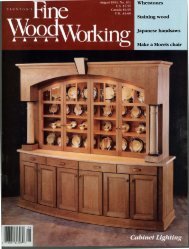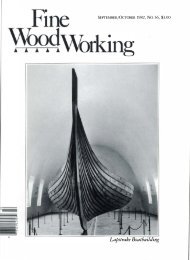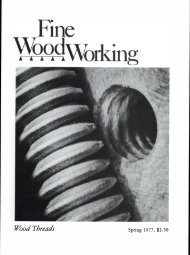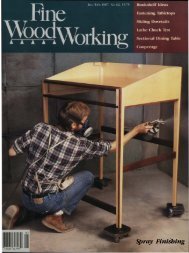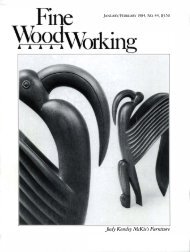NOVEMBER/DECEMBER 1983, No. 43, $3.50 Making ... - Wood Tools
NOVEMBER/DECEMBER 1983, No. 43, $3.50 Making ... - Wood Tools
NOVEMBER/DECEMBER 1983, No. 43, $3.50 Making ... - Wood Tools
Create successful ePaper yourself
Turn your PDF publications into a flip-book with our unique Google optimized e-Paper software.
Adhesive<br />
Hide glue (hot)·<br />
(Behlen Ground Hide Glue, be<br />
ADHESIVE SELECTION GUIDE<br />
Application characteristics Properties after curing<br />
Fast tack, viscous, min. curing Transparent, not watertemp.<br />
60°F, moderate gap- resistant, can sanded<br />
Recommended uses<br />
Musical instrumenrs,<br />
furniture<br />
Behlen Pearl Hide Glue) filling ability, nontoxic, requires<br />
glue pot<br />
Hide glue (liquid)· Slow-setting, low viscosity, min.<br />
(Franklin Liquid Hide Glue) curing temp. 70°F, moderate<br />
gap-ftlling ability, nontoxic,<br />
may have strong odor<br />
Casein glue· Glue must stand 10 to 20<br />
(National Casein #30, slow minutes after mixing, min.<br />
cure; National Casein curing temp. 35°F, moderate<br />
#8580, fast cure) gap-filling ability, nontoxic<br />
White glue·<br />
(Elmer's White Glue,<br />
Franklin Evettite, Weldbond,<br />
Wilhold RIC-56)<br />
Cures rapidly, low viscosity,<br />
min. curing temp. 60°F,<br />
moderate gap-filling ability,<br />
nontoxic, almost unlimited<br />
Yellow glue·<br />
(Elmer's Carpenter's <strong>Wood</strong><br />
Glue, Franklin Titebond)<br />
Urea-formaldehyde glue·<br />
(Weldwood Plastic Resin<br />
shelf life<br />
be<br />
Fast tack, moderate viscosity<br />
increasing with age, min. curing<br />
temp. 60°F, moderate<br />
gap-ftlling ability, nontoxic<br />
Glue powder must mixed<br />
with water, min. curing temp.<br />
Glue, Wilhold Plastic 70°F", poor gap-filling<br />
Resin Glue) ability, releases formaldehyde<br />
vapor, uncured glue is toxic<br />
Resorcinol glue Moderate viscosity, min. curing<br />
(Elmer's Waterproof Glue, temp. 70°F", good gap-filling<br />
U.S. Plywood Resorcinol, ability, releases formaldehyde<br />
Wilhold Resorcinol) during curing, two-part system<br />
must be mixed, uncured glue<br />
is toxic<br />
• Warer-based adhesive may cause warping of veneer or chin panels.<br />
be extended by adding up to 60% wheat flour or fme wood<br />
dust. The thermosetting nature of urea-formaldehyde glues<br />
can be both boon and bane. In a shop cooler than 70°F they<br />
will cure poorly or not at all, but at 90°F the mixture's potlife<br />
is only one to two hours. Once the glue is spread and the<br />
pieces clamped, curing can be hastened by heating the glueline<br />
to between 90°F and 150°F. Urea-formaldehyde's thermosetting<br />
qualities make it the most popular adhesive for use<br />
FWW with the radio-frequency curing apparatus described in<br />
#38, p. 26.<br />
One drawback of urea-formaldehyde glues is the emission<br />
of formaldehyde gas during and after curing. Besides being a<br />
suspected carcinogen, this vapor may irritate the skin and eyes<br />
and cause headaches. The problem is liable to be most pronounced<br />
in homes consttucted with urea-formaldehyde-glued<br />
paneling, but it's a good idea to work with this adhesive only<br />
in a well-ventilated shop.<br />
The development of urea-formaldehydes marked a milestone<br />
on the road to the perfea waterproof glue sought by<br />
boatbuilders for centuries. Ironically, completely waterproof<br />
adhesives didn't appear until the wooden ship was nearly extinct.<br />
Today, resorcinol-formaldehyde glue is the most popular<br />
waterproof wood adhesive, with epoxy resin trailing as an<br />
expensive second choice. Resorcinol glue was developed during<br />
World War II for gluing the plywood used in bombers,<br />
64<br />
Similar to hot hide glue Assembly procedures that<br />
require slow setting<br />
Neutral opaque color, high Interior StruCtural applications,<br />
water-resistance, sands especially good with oily<br />
deanly woods and in cool working<br />
temperatures<br />
Transparent, low water- General woodworking, not<br />
resistance, creeps under recommended for struCtural<br />
load, dogs sandpaper or outdoor applications<br />
Nearly transparent, moderate General woodworking, indoor<br />
water-resistance, less likely to. use only<br />
creep under load than white<br />
glue, can be sanded<br />
be Medium brown color, high General woodworking, struCtural<br />
water-resistance, sands deanly, uses indoors or in sheltered<br />
thick gluelines are brittle outdoor locations, bonding may<br />
and may crack under stress with oily woods<br />
Opaque reddish color, Marine use and outdoor<br />
waterproof, withstands most construction<br />
solvents and caustic chemicals,<br />
can be sanded<br />
inhibited<br />
be 90°F 150°F.<br />
.. May rapidly hear-cured ar ro<br />
helicopter blades and antimagnetic mine sweepers. Today, it is<br />
used to bond marine and exterior plywood, and for laminating<br />
outdoor timbers. For the home shop, resorcinol is sold retail<br />
as a two-part system consisting of a dark red liquid resin, and<br />
a<br />
u.s.<br />
solid powder containing paraformaldehyde and an inert filler<br />
(usually powdered nutshells). Two brands are Wilhold and<br />
Plywood, both marketed as waterproof glue.<br />
Resorcinol is fairly costly, and once mixed it must be used<br />
within an hour or two. For these reasons, it should be the<br />
glue of choice only when a completely waterproof joint<br />
full<br />
is<br />
needed. It requires a minimum setting temperature of 70°F,<br />
and solidifies within eight hours, though it doesn't reach<br />
bond strength for several days. Acidic hardwoods such as oak<br />
may require lOO°F to HO°F temperatures for maximum<br />
bonding. The final glue film is extremely durable, tolerating<br />
boiling water, caustic chemicals and drastic temperature variations.<br />
Resorcinol glue is easy to apply and can be cleaned up<br />
with a damp rag. Disadvantages include<br />
FWW FWW<br />
0<br />
the dark reddish<br />
glueline and the release of formaldehyde during curing.<br />
George Mustoe is a geochemistry research technician at<br />
Western Washington University in Bellingham, Wash.<br />
He wrote about respiratory hazards in #41 and<br />
about making cross-country skis in #31. Photos by<br />
the author.



